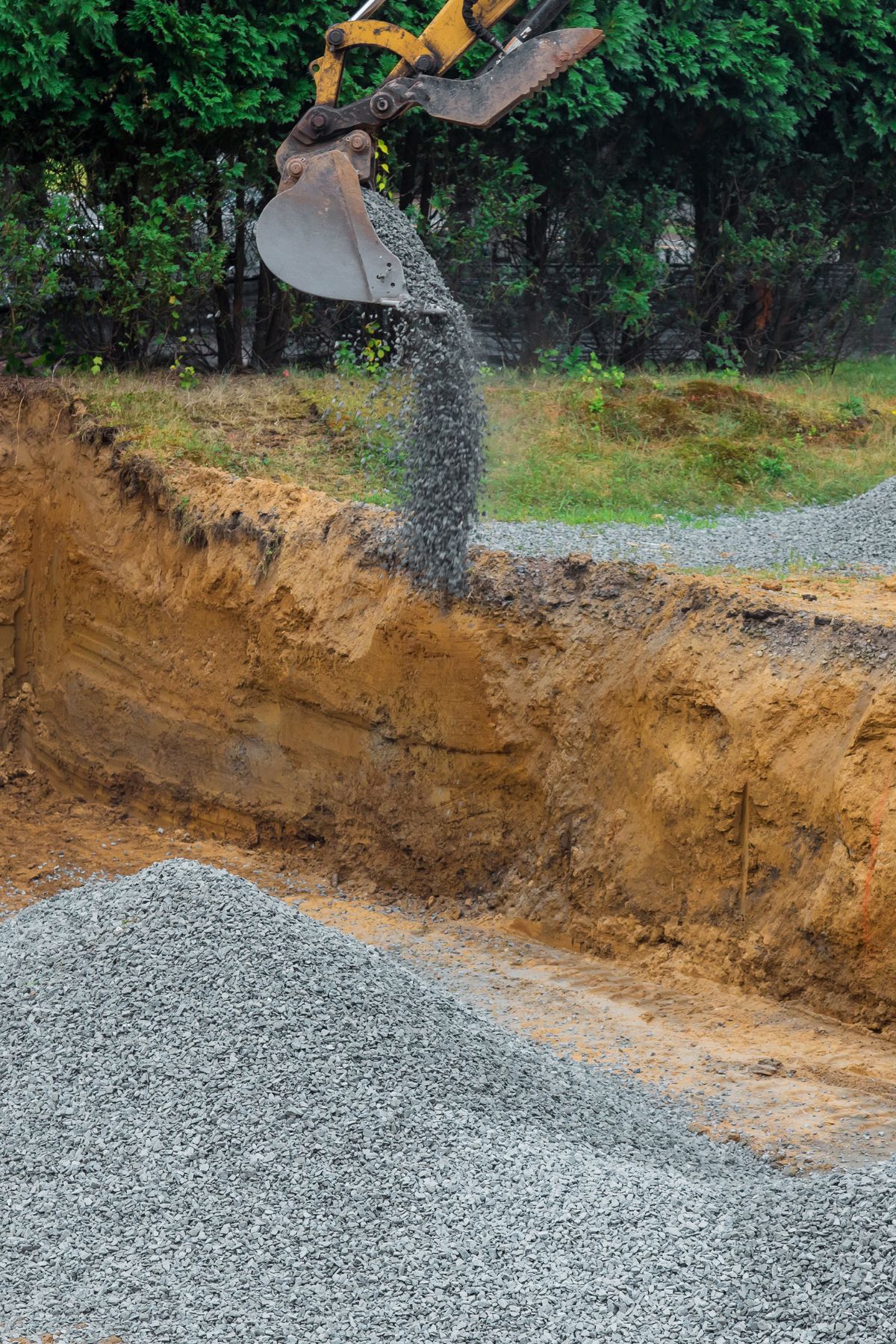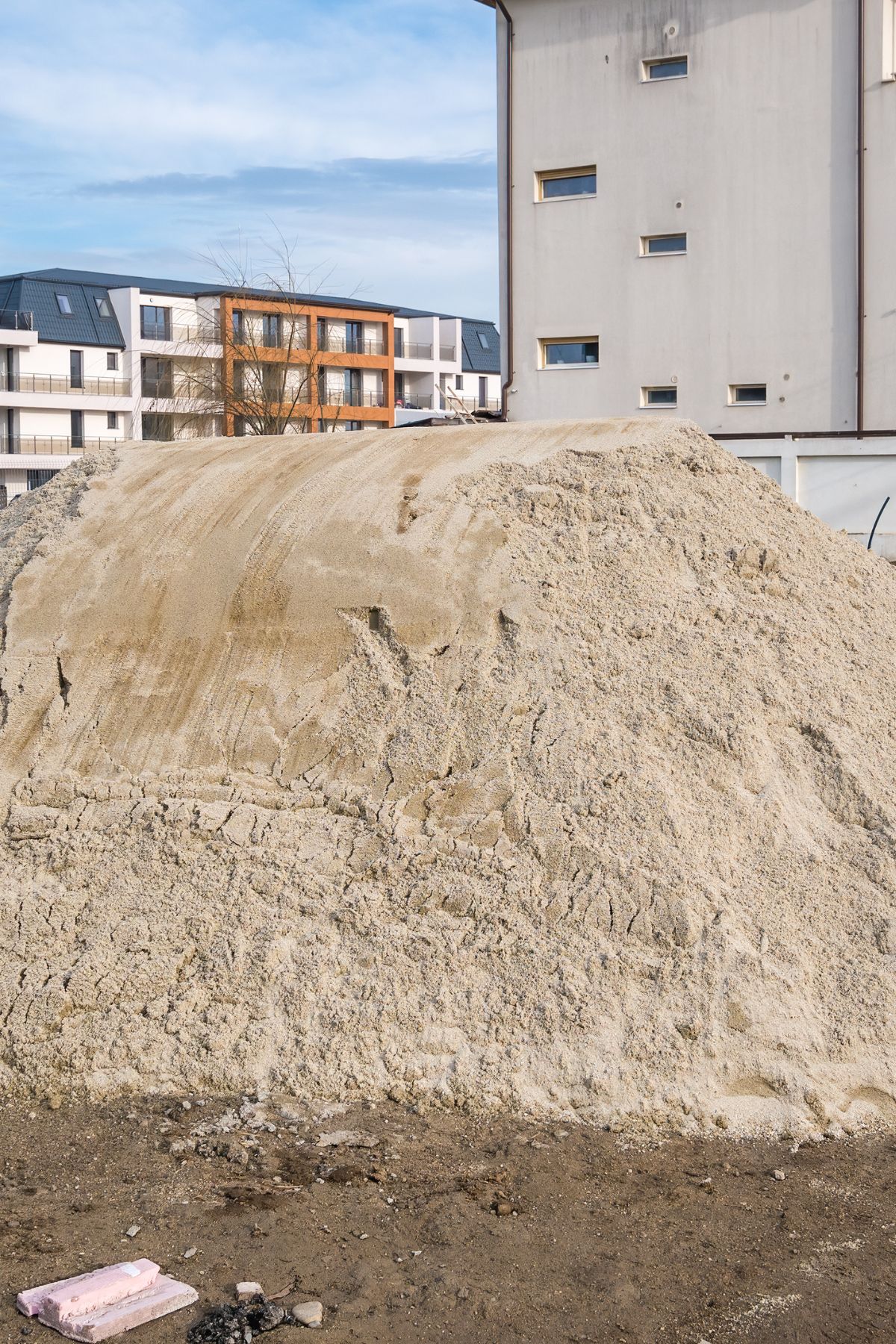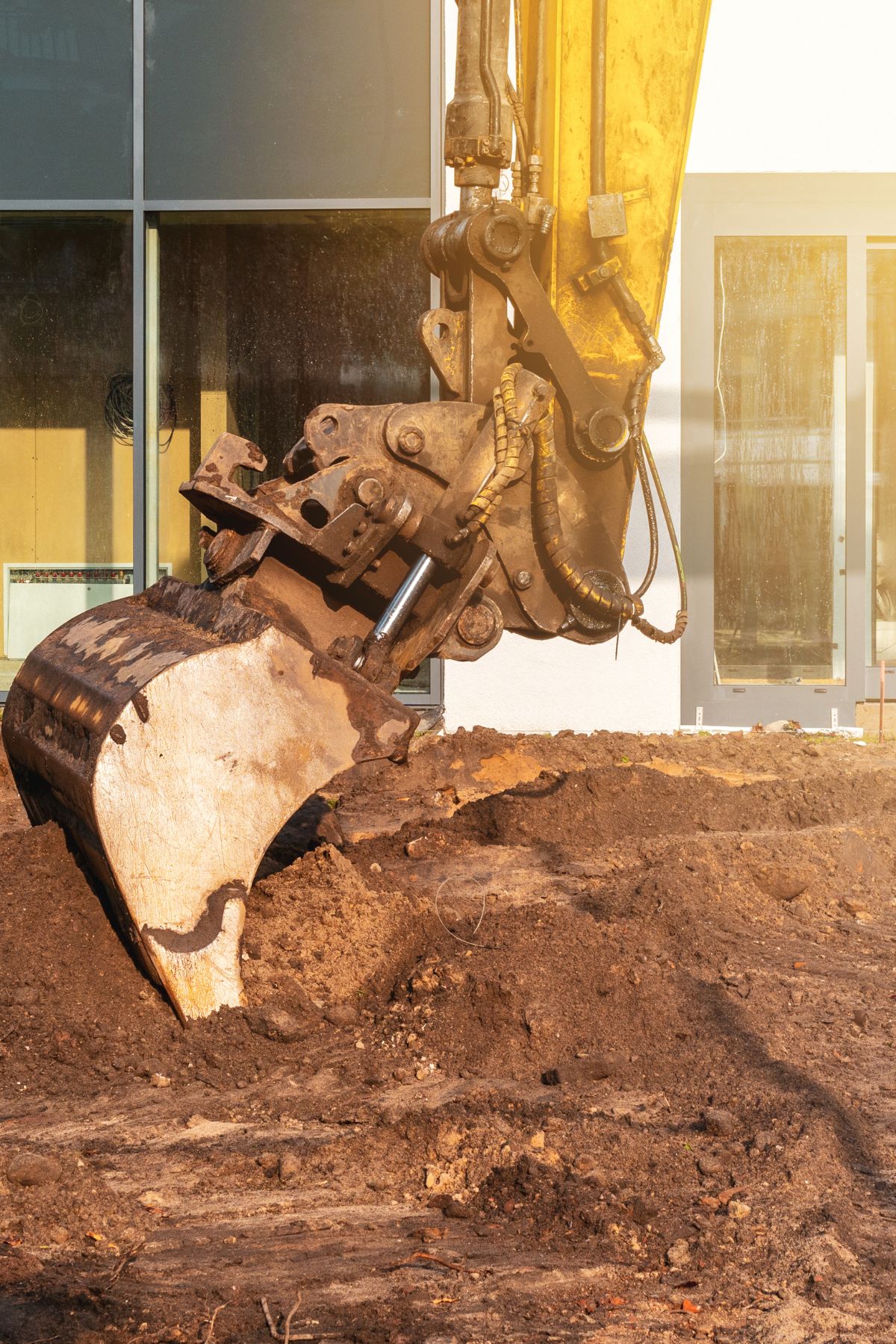This Backfill Dirt Calculator helps you estimate how much fill material you’ll need—accurately and instantly.
Backfill Dirt Calculator
Cost Estimation (optional)
Whether you’re filling a trench, backfilling around a foundation, leveling a yard, or pouring a patio base, ordering the correct amount of soil or gravel is critical. Order too little and you’ll face delays and expensive second deliveries. Order too much and you’ve paid for material you didn’t need. This calculator solves that problem by converting your project dimensions into cubic yards, tons, loose yardage, and even estimated material and delivery cost.

Why Backfill Volume Really Matters
Anytime you dig soil out of the ground, it expands and becomes aerated. Then, when you place that soil back into the hole—or replace it with gravel, sand, clay, or fill dirt—it settles and compacts. That means the amount of loose material you need is NOT the same as the final compacted volume.
A small mistake of just 10–15% can mean:
- A second delivery (and a second delivery charge)
- Project delays
- Wheelbarrow hauling or machine rental the next day
- Uneven settling after rain or weight load
- Structural problems for patios, driveways, retaining walls, or footings
This is why professional estimators calculate:
✅ Final compacted volume
✅ Loose material needed before compaction
✅ Material weight in tons
✅ Truckloads needed to move it
Our calculator does all of that automatically.
How Backfill Volume Is Measured
Backfill is typically measured in three different ways:
| Measurement Type | Used For | Why It Matters |
|---|---|---|
| Cubic Feet | Raw excavation or hole size | Good for measuring small projects |
| Cubic Yards | Ordering bulk material | Most suppliers sell by cubic yard |
| Tons | Gravel, crushed stone, clay, sand | Weight determines pricing & truck limits |
✅ Converting Units
Most backfill questions start like this:
“How many cubic yards do I need?”
To find that, you convert cubic feet to cubic yards:
1 cubic yard = 27 cubic feet
So if your hole has 270 cubic feet of volume:
270 ÷ 27 = 10 cubic yards
But that’s only the compacted amount. When you add compaction, loose volume becomes larger.
Example with 20% compaction factor:
Compacted Volume: 10 cubic yards
Loose Volume: 10 × 1.20 = 12 cubic yards
Order 12 cubic yards, not 10 — otherwise the surface will sink after the soil settles.
This is where most DIYers underestimate their material needs. Our calculator prevents that by applying a compaction factor automatically.
Backfill Materials and Their Densities
Not all fill weighs the same. One cubic yard of fluffy topsoil weighs far less than one cubic yard of gravel or clay. This matters when pricing material and calculating truck capacity.
Here are common backfill materials and their approximate densities:
| Material | Typical Use | Approx. Weight (tons per cubic yard) |
|---|---|---|
| Fill Dirt | General backfill, leveling | 1.3 |
| Compacted Dirt | Base layers, under structures | 1.6 |
| Topsoil | Landscaping, gardens | 1.1 – 1.3 |
| Sand | Drainage, pavers, pipes | 1.35 |
| Gravel | Driveways, retaining walls, foundations | 1.5 |
| Crushed Stone | Road bases, structural support | 1.6 |
| Clay | Pond lining, sealing, retaining | 1.65 |
Because your supplier may quote prices per cubic yard or per ton, our Backfill Dirt Calculator shows both.
Example:
If you need 14 loose cubic yards of gravel:
14 yd³ × 1.5 tons/yd³ = 21 tons
If gravel costs $40 per ton, that’s:
21 tons × $40 = $840 in material
And if delivery is $75, total becomes $915.
With our calculator, you don’t need to do any of this math by hand.

Why Compaction Changes Everything
Here’s the part most people don’t realize:
When dirt comes out of the ground, it’s compact and dense.
When you put it back, it contains air pockets—and it settles.
That’s why you always need MORE loose soil than the final compacted volume.
Typical compaction factors:
| Compaction Level | Multiplier | When It’s Used |
|---|---|---|
| Light (1.10) | Grass areas, light traffic | Topsoil, garden fill |
| Medium (1.20) | Most construction sites | Fill dirt, sand, loose soil |
| Heavy (1.30) | Load-bearing areas | Driveways, patios, foundations |
Example:
You’re backfilling a trench that needs 10 compacted cubic yards.
- Light compaction → order 11 yards
- Medium compaction → order 12 yards
- Heavy compaction → order 13 yards
A one-yard difference might not sound like much—but if a dump truck costs $200–$500 per delivery, a miscalculation becomes expensive fast.
This is why we added compaction factors directly into the calculator.
How to Use the Backfill Dirt Calculator (Step-by-Step)
One of the advantages of this Backfill Dirt Calculator is that it works for nearly any project and doesn’t require any math on your part. Just enter the dimensions you know, select your material, and the calculator does the rest.
Here’s how to use it correctly:
✅ Step 1 — Choose the Shape of Your Project Area
Different projects have different geometries, so the calculator allows you to choose:
- Rectangle / Square – patios, foundations, raised areas, yards, driveways
- Circle (Cylinder) – wells, tanks, round ponds, post holes
- Trench – electrical conduit, irrigation, water lines, sprinkler systems
Choosing the right shape ensures accurate volume calculation.
✅ Step 2 — Enter Length, Width, or Diameter
Depending on the shape selected:
- Rectangle/Trench → Length & Width
- Circle → Diameter
Enter all dimensions in feet.
Example:
If you are installing a circular above-ground pool base that is 22 feet wide, enter:
- Shape: Circle
- Diameter: 22 ft
✅ Step 3 — Enter Depth
Depth can be entered in inches or feet, depending on how you measure.
For example:
- 6-inch layer of gravel under a shed → enter 6 inches
- 2-foot backfill around a foundation → enter 2 feet
The calculator automatically converts inches to feet internally.
✅ Step 4 — Select Backfill Material
Different backfill materials have different densities, which change the total weight in tons and cost.
Options include:
- Fill dirt
- Compacted dirt
- Sand
- Gravel
- Crushed stone
- Clay
- Custom density (for special materials)
If you are not sure what density to choose, “Fill Dirt (1.3 tons/yd³)” is the most common default for general backfill projects.
✅ Step 5 — Select a Compaction Factor
This is where the calculator becomes more accurate than most others online.
You can choose:
- No compaction (1.00)
- Light (1.10)
- Medium (1.20)
- Heavy (1.30)
- Custom
If you’re working under a driveway, patio, or structure, medium or heavy compaction is recommended.
✅ Step 6 — (Optional) Add Cost Per Yard, Ton, or Delivery Fee
If you know the pricing from your supplier:
- Enter cost per cubic yard
- Or cost per ton
- And add a delivery fee if applicable
The calculator will instantly show total estimated cost.
If you leave these blank, the calculator will simply provide volumes and weights with no cost output.
✅ Step 7 — Click “Calculate”
Your results will include:
- Compacted Volume (final fill volume)
- Loose Yardage (amount you must order)
- Tons of material needed
- Estimated cost
- Truckload equivalents in 10, 12, and 16 cubic yard trucks
Most people are surprised to learn how much volume increases after compaction.

How to Estimate the Cost of Backfill Dirt
Understanding volume is only half the equation—your budget matters just as much. Fill dirt, sand, gravel, and crushed stone are generally sold either by the cubic yard or by the ton. Each supplier prices differently, which is why this calculator allows both pricing methods.
Here’s how pricing is commonly structured:
| Pricing Method | When Suppliers Use It | Best For |
|---|---|---|
| Cost per cubic yard | Topsoil, fill dirt, clean fill | Homeowners, landscapers |
| Cost per ton | Gravel, sand, clay, crushed stone | Driveways, structural backfill |
| Delivery fee | Each truckload | Small and large projects |
A realistic estimate should include material and delivery.
Typical Price Ranges (by Material)
Prices vary based on location, distance, and availability, but here are average U.S. ranges:
| Material | Price per Cubic Yard | Price per Ton |
|---|---|---|
| Fill Dirt | $10 – $25 | $8 – $15 |
| Topsoil | $18 – $50 | $15 – $25 |
| Sand | $15 – $35 | $20 – $45 |
| Gravel | $25 – $55 | $30 – $65 |
| Crushed Stone | $30 – $75 | $35 – $90 |
| Clay | $10 – $40 | $20 – $45 |
How the Calculator Uses Prices to Estimate Cost
If you enter:
- Cost per cubic yard → The calculator multiplies by loose yardage
- Cost per ton → The calculator multiplies by tons required
- Delivery cost → Adds it as a flat fee
You see both yard-based and ton-based pricing so you can compare quotes.
Understanding Truckloads
Suppliers rarely deliver small amounts. Most use dump trucks that carry between 8 and 16 cubic yards. The calculator estimates truckloads using three common truck sizes:
| Truck Size | Typical Use |
|---|---|
| 10-yard truck | Most local deliveries |
| 12-yard truck | Commercial or heavy fill |
| 16-yard truck | Large construction, long hauls |
How much does a dump truck of dirt hold?
Most dump trucks hold 10–14 cubic yards. Larger trucks hold 16 yards, and commercial trailers carry even more.
How many tons can a dump truck carry?
Typical small dump trucks carry 10–15 tons. Larger haulers carry 16–20+ tons, depending on weight limits.
How much dirt do I need to fill a hole?
Measure length × width × depth to get cubic feet, then divide by 27 to get cubic yards. Or simply enter the dimensions into the calculator.
How many cubic yards are in a ton?
It depends on the material:
Fill dirt ≈ 1.3 tons per cubic yard
Gravel ≈ 1.5 tons per cubic yard
Clay ≈ 1.65 tons per cubic yard
Does backfill dirt settle over time?
Yes. That’s why compaction is essential. Without it, the ground will sink, causing uneven surfaces or structural problems.
How deep should backfill be around a foundation?
Common backfill depths range from 2–6 feet depending on foundation height. Compaction is critical to prevent settling.
Conclusion
Whether you’re a homeowner leveling a backyard or a contractor preparing for a foundation pour, getting the right amount of backfill is critical. Too much wastes money, too little delays the project. The Backfill Dirt Calculator removes the guesswork and gives you numbers you can trust—cubic yards, tons, loose vs compacted volume, truckloads, and even cost estimates.
💡 Try the calculator now.
Enter a few simple measurements and get instant results. You’ll know exactly how much material to order—and how much it will cost—before you pick up the phone.
